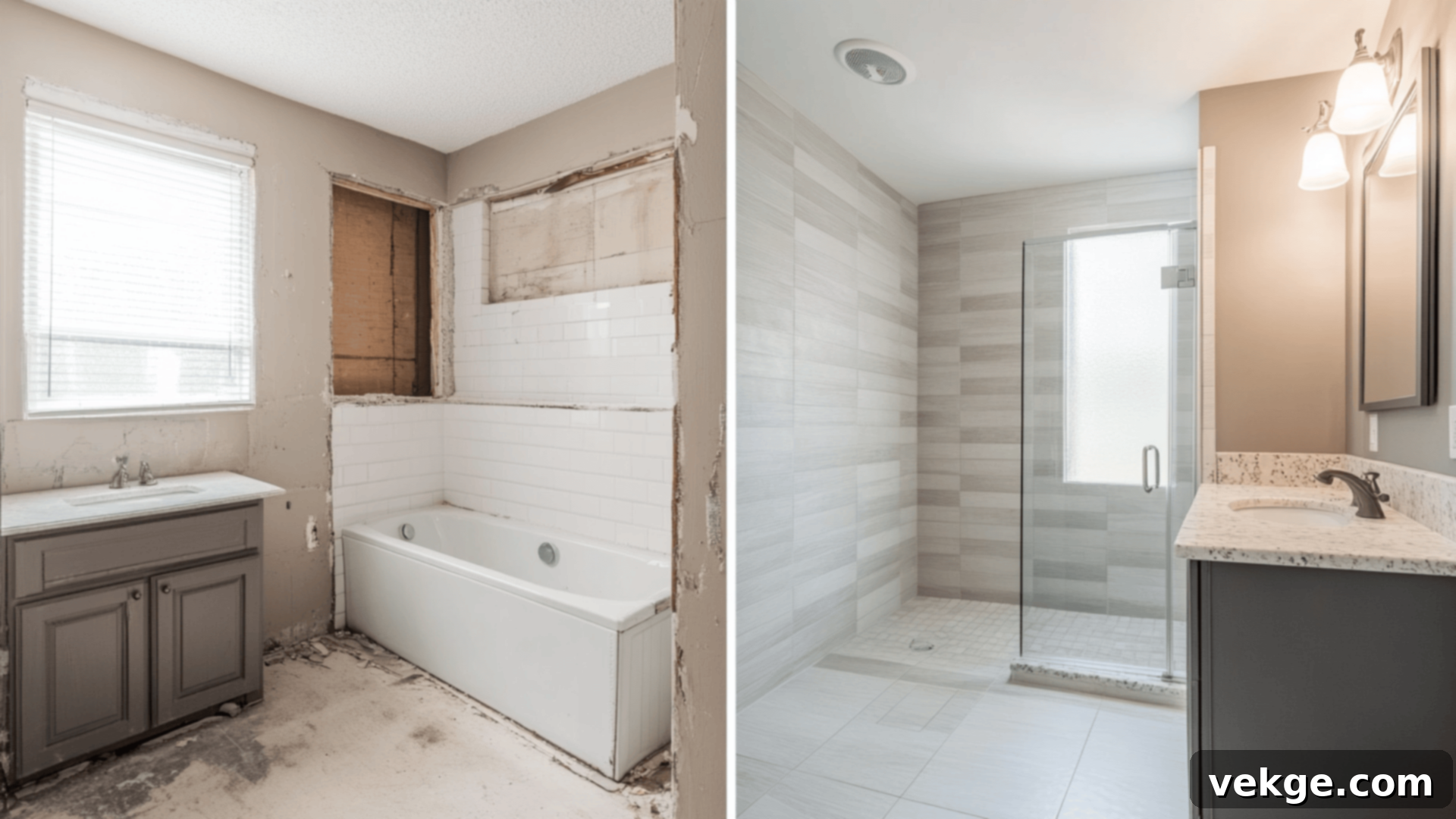Bathroom Renovation Costs: Your Ultimate Guide to Budgeting, Saving & Maximizing Value
Dreaming of a fresh new look for your bathroom but concerned about the potential expense? You’re not alone. Bathroom renovations, while exciting, can often bring a wave of stress when trying to balance design aspirations with a realistic budget.
This comprehensive guide is designed to equip you with all the essential knowledge about bathroom renovation costs. We’ll delve into average prices across different project scales, unveil smart strategies to save money without compromising quality, and provide invaluable tips to ensure you get the absolute best value for your investment.
Whether your vision involves a simple cosmetic refresh or a complete, luxurious overhaul, you’ll find clear, actionable advice here. Our goal is to empower you to make informed decisions confidently, transforming your bathroom into a space you love without the financial worry.
Ready to understand the true cost of a bathroom renovation and how to execute it flawlessly? Let’s begin your journey to a beautifully updated bathroom.
How Much Does a Bathroom Renovation Really Cost?
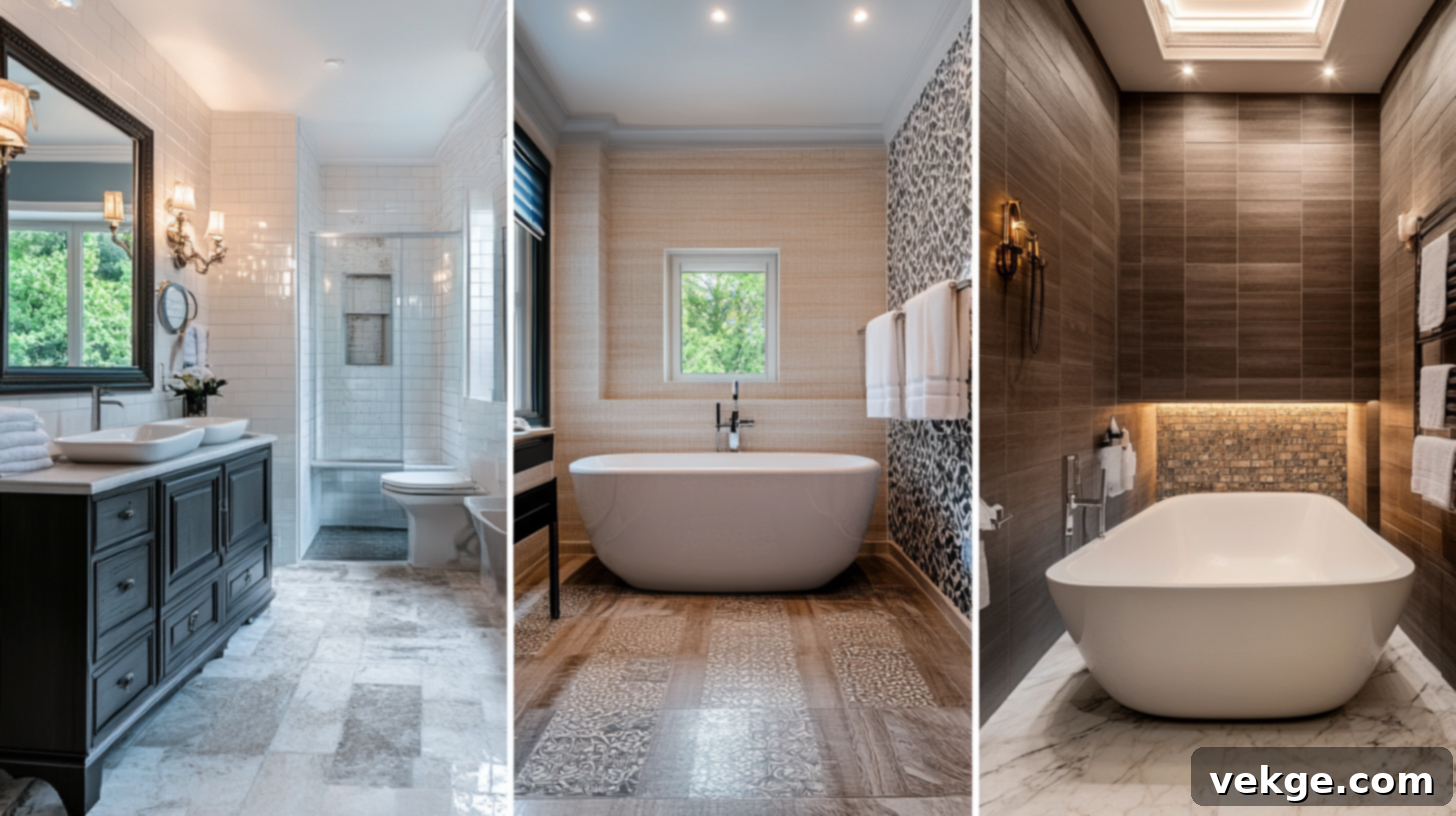
The total cost of a bathroom renovation can fluctuate dramatically, primarily influenced by factors such as your geographic location, the bathroom’s size, and the overall scope of the project. Understanding these variables is crucial for setting realistic expectations and planning effectively.
Below, we provide a detailed breakdown of national average costs, categorized by the type and scale of the bathroom.
Cost Tiers for Bathroom Renovations
These cost tiers offer a framework for homeowners to anticipate expenses based on the bathroom type and desired level of renovation. The physical dimensions and existing condition of your bathroom directly impact the required investment.
Smaller areas, such as a compact half-bathroom (powder room), typically demand a lower investment, focusing on essential updates. In contrast, larger master bathrooms present greater opportunities for expansive, luxurious upgrades and highly personalized design elements, naturally leading to higher costs.
| Bathroom Type | Typical Cost Range | Average Renovation Scope |
|---|---|---|
| Half Bathroom (Powder Room) | $2,000 – $5,000 | Primarily cosmetic updates, including new sink, toilet, fresh paint, updated mirror, and lighting fixtures. Focus on aesthetic improvements. |
| Full Bathroom (Guest/Standard) | $6,000 – $15,000 | Moderate upgrades such as replacing essential fixtures (vanity, toilet, shower/tub combo), new flooring, a fresh coat of paint, and improved lighting. Enhanced functionality and style. |
| Main Bathroom (Master/Large) | $10,000 – $30,000+ | Extensive renovations that might include layout changes, high-end finishes, custom cabinetry, luxurious walk-in showers, freestanding tubs, advanced lighting, and smart home technology integration. |
Bathroom Remodel Budget Breakdown by Type
Categorizing renovations into distinct budget tiers helps homeowners strategically plan their bathroom projects. Each tier presents unique opportunities and limitations, allowing you to carefully balance your design aspirations with practical financial constraints. The optimal approach will depend on your specific needs, your home’s overall value, and your long-term goals for the property.
1. Budget Renovation ($3,000–$10,000)
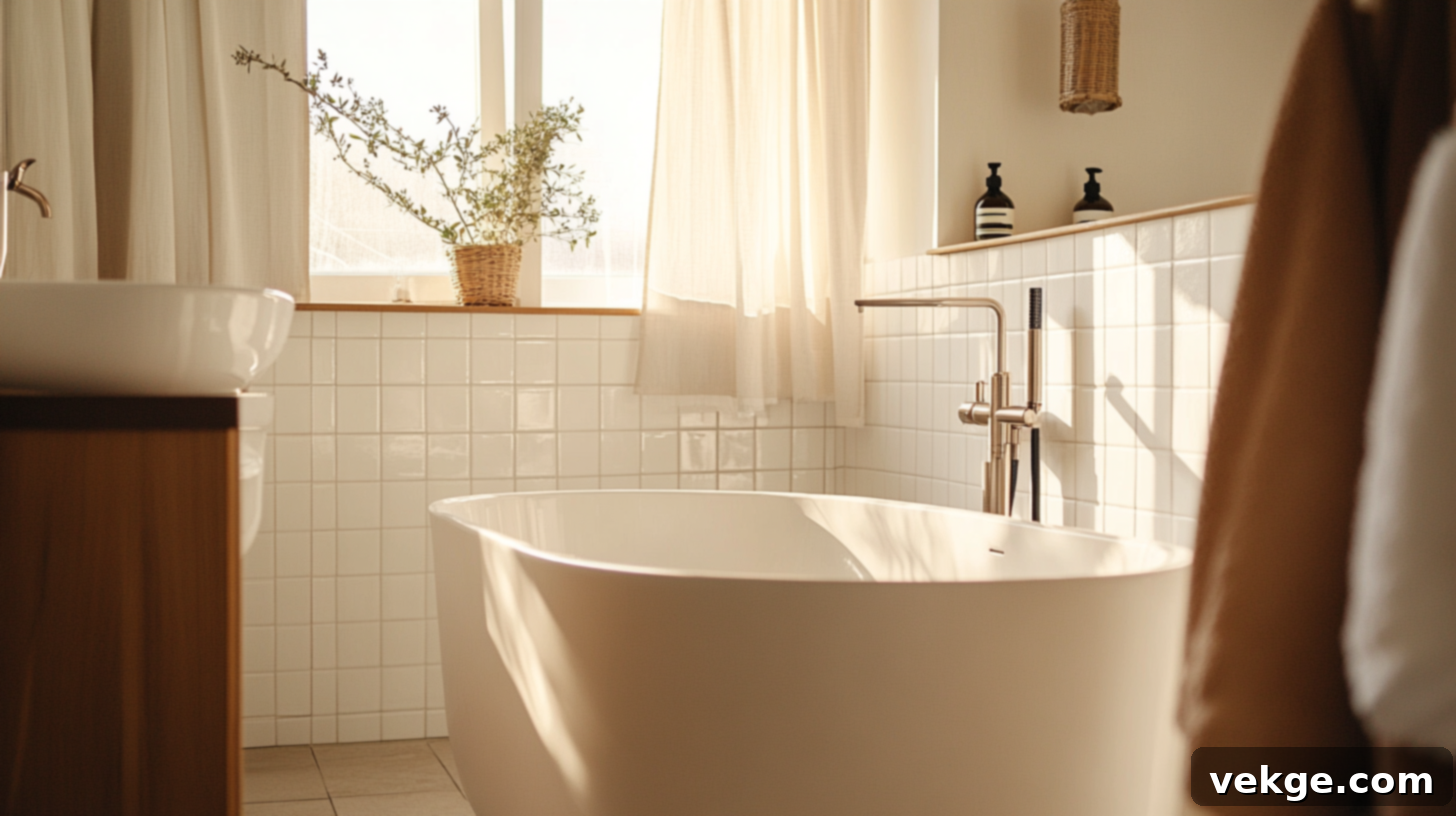
This entry-level renovation tier is ideal for homeowners operating on a tight budget who still desire a noticeable refresh for their bathroom. The primary focus here is on cost-effective cosmetic improvements that can significantly enhance the bathroom’s appearance without necessitating extensive structural modifications.
Typical updates within this range often include applying a fresh coat of paint to revitalize wall colors, replacing outdated faucets and showerheads with more modern, affordable alternatives, updating existing lighting fixtures for better illumination, and making minor aesthetic enhancements such as a new mirror or towel bars. The goal is to breathe new life into the space through smart, budget-friendly choices that improve its overall look and feel.
2. Mid-Range Renovation ($10,000–$25,000)
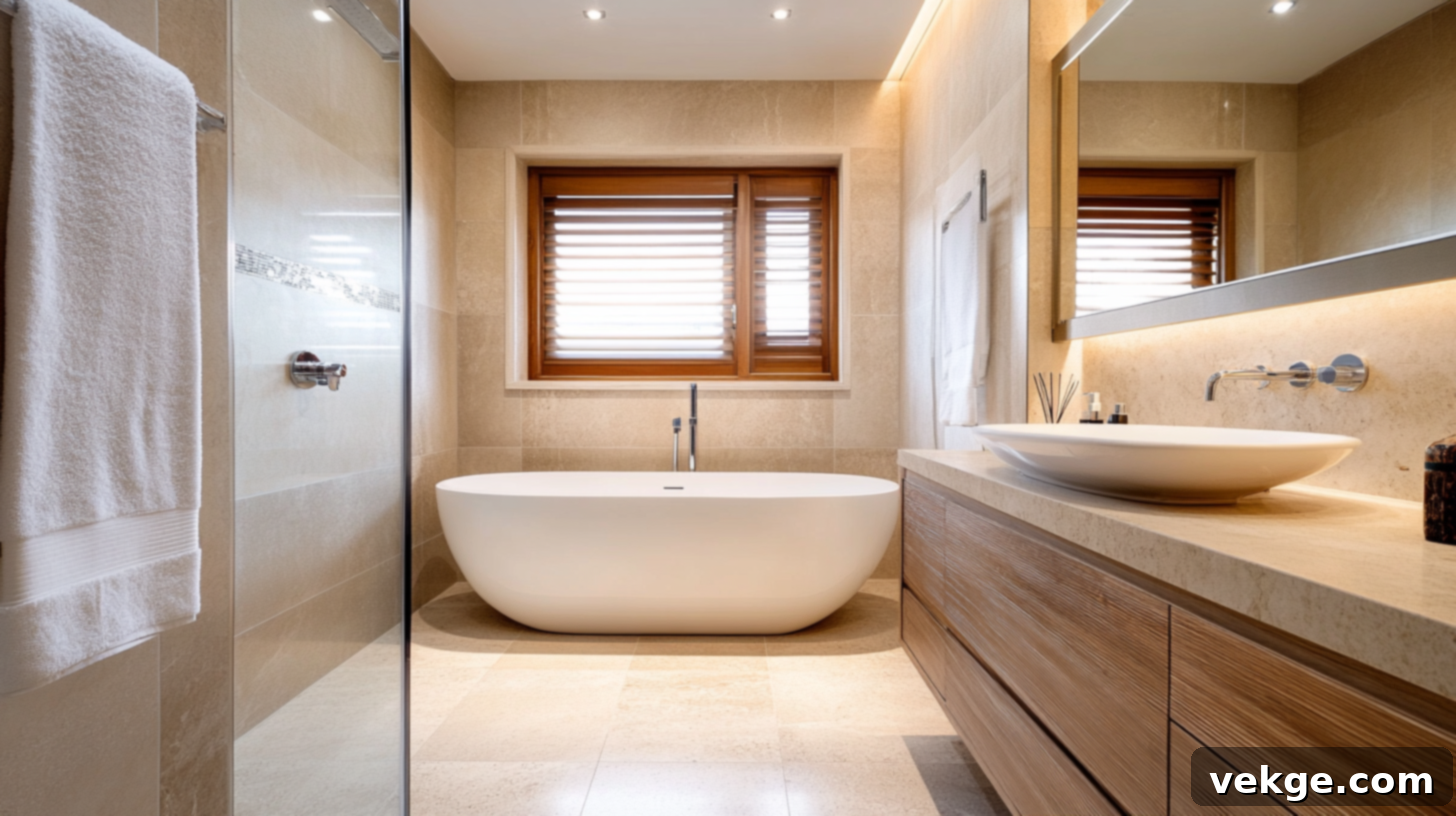
Stepping up to the mid-range budget tier opens the door to more substantial and impactful updates for your bathroom. Homeowners can now invest in higher-quality materials and more significant changes that go beyond simple surface-level improvements.
This budget allows for installing new tile flooring or an attractive backsplash that adds character and durability. You can replace the existing vanity with a modern design, potentially opting for semi-custom options, and upgrade lighting fixtures to not only improve functionality but also enhance the room’s ambiance. Partial plumbing upgrades become feasible, enabling minor reconfigurations or the replacement of aging pipes. Additionally, incorporating better quality materials throughout ensures increased durability and aesthetic appeal, creating a more refined and functional bathroom space.
3. High-End Renovation ($25,000–$50,000+)
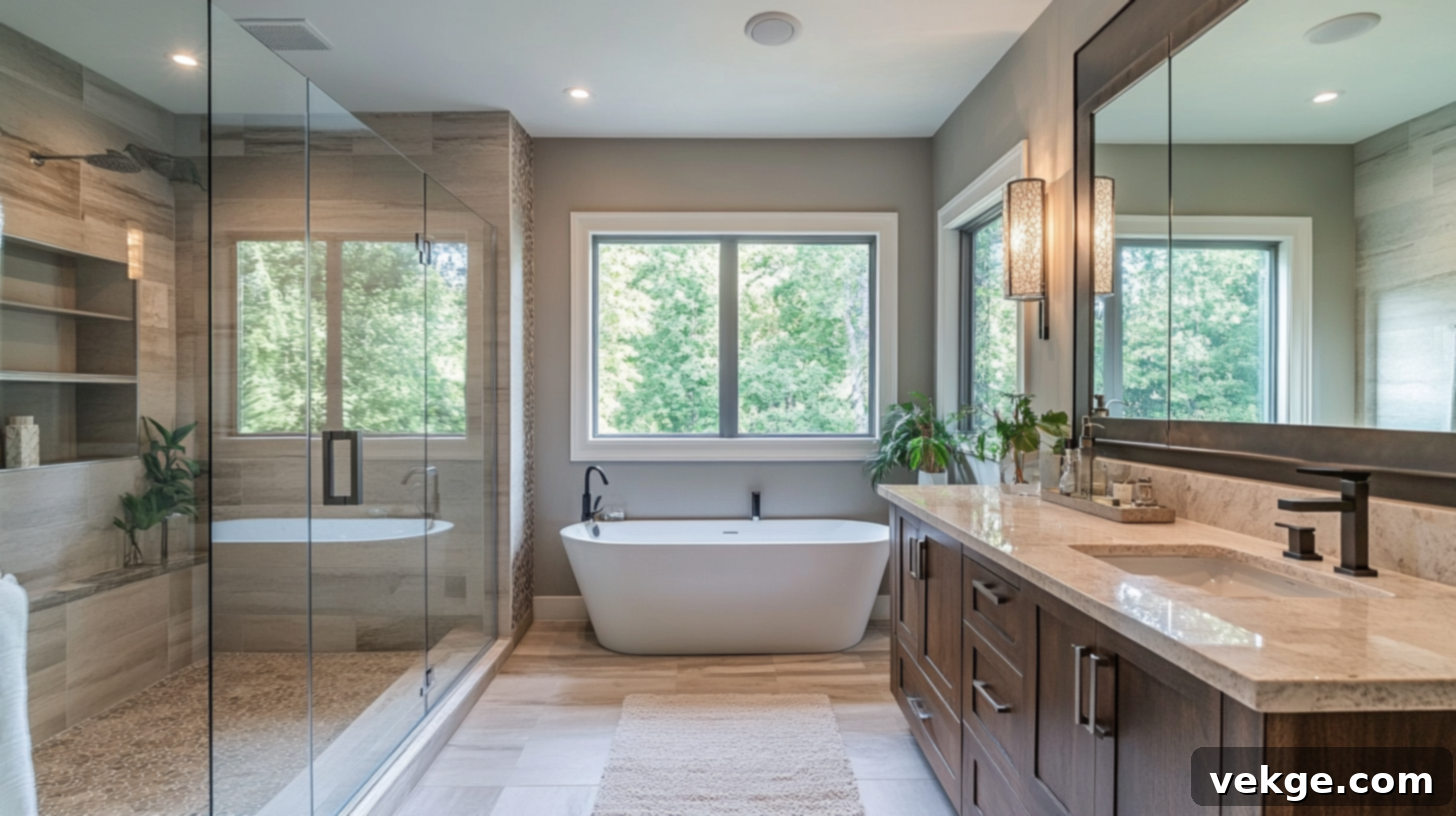
For those aspiring to a truly luxurious transformation, the high-end renovation tier represents the pinnacle of bathroom design, functionality, and comfort. This budget allows for a complete reimagining of the bathroom space, going far beyond basic improvements.
Homeowners can indulge in a comprehensive layout redesign, integrating cutting-edge smart home technology for an ultra-modern and sophisticated environment. Custom luxury finishes, such as premium natural stone tiles, bespoke cabinetry, and designer fixtures, elevate the bathroom into a personal sanctuary. Specialized features like heated flooring, expansive walk-in rainfall showers with multiple jets, freestanding soaking tubs, and advanced lighting systems (including mood lighting) transform everyday routines into spa-like experiences. These renovations not only enhance aesthetic appeal but also provide unparalleled comfort and a highly personalized retreat.
What Impacts Your Bathroom Renovation Cost?
Bathroom renovations involve numerous cost factors, each playing a significant role in determining your project’s overall expense. A thorough understanding of these elements empowers homeowners to plan more effectively, anticipate potential challenges, and avoid unexpected financial burdens. Every single aspect, from the initial demolition to the final touches, contributes to the ultimate price tag, making meticulous planning indispensable for a successful and cost-efficient bathroom upgrade.
1. Labor Costs
Labor is often the largest component of renovation expenses, typically accounting for 40–65% of the total project cost. Skilled contractors, including plumbers, electricians, tile setters, and general contractors, usually charge between $50 and $75 per hour, although this can vary significantly. More complex projects, especially those requiring specialized skills or extensive custom work, will naturally incur higher labor fees.
Furthermore, your home’s geographic location heavily influences labor rates. A renovation that costs a certain amount in a lower cost-of-living area could be substantially more expensive in a major metropolitan hub due to higher wages and demand for skilled tradespeople.
2. Material Choices
The selection of materials is another major determinant of your renovation budget. Opting for premium, high-end materials will dramatically increase costs compared to more budget-friendly alternatives.
- Tiles: Prices range from $0.50 per square foot for basic ceramic tiles to over $15 per square foot for porcelain, natural stone (marble, granite), or intricate mosaic designs. Installation costs are additional.
- Countertops: Expect to pay anywhere from $400 for a basic laminate option to $4,300+ for high-end quartz, granite, or custom concrete countertops, depending on the material, slab size, and fabrication complexity.
- Faucets: Standard chrome faucets might cost $170, while designer fixtures with special finishes (matte black, brushed gold) or advanced features can easily reach $360 or more.
- Cabinetry: Costs vary widely from $300 for a basic stock vanity to $42,000+ for custom-built, high-quality wood cabinetry with specialized features and finishes. Semi-custom options fall in the middle.
The quality, durability, and aesthetic appeal of the materials you choose will directly impact both the upfront cost and the long-term enjoyment and value of your bathroom.
3. Layout and Structural Changes
Any modifications to the existing bathroom layout or structural elements can substantially increase renovation costs due to the complexity and labor involved.
- Plumbing relocation: Moving a toilet, sink, or shower requires re-routing water supply and drain lines, typically costing $905 to $1,098 per piping run. This often necessitates opening walls and floors.
- Electrical work: Relocating outlets, installing new lighting, or adding heated floors involves electrical wiring installation, which can cost $6 to $8 per linear foot, plus the cost of fixtures and licensed electrician fees.
- Structural wall changes: Removing or adding walls (especially load-bearing ones) is a significant undertaking. Costs vary widely based on the scope of work, materials used, engineering assessments, and the need for new support beams. This type of work almost always requires permits.
These complex changes demand professional expertise from licensed tradespeople and can quickly escalate the overall project expense. They also often trigger the need for specific permits and inspections.
4. Unexpected Costs
It’s vital that every renovation budget includes a contingency fund for potential surprises. Homeowners might encounter a range of unforeseen issues during demolition, such as existing water damage or rot behind walls, outdated or non-code-compliant plumbing or electrical wiring, the presence of asbestos or mold remediation, or unexpected structural problems within the subfloor or framing.
Additionally, permit fees, which vary by municipality, are an essential but often overlooked expense. Experts strongly recommend setting aside 10–15% of the total estimated budget specifically as a contingency fund to gracefully cover these unforeseen expenses without derailing your project.
5. Professional vs. DIY Comparison
The decision between hiring professionals for a full renovation and undertaking a do-it-yourself (DIY) approach is a critical one, impacting both your budget and the final quality of the result. This choice largely hinges on your personal skill level, the time you can dedicate, your financial constraints, and the overall complexity of your desired renovation.
While a DIY approach can significantly reduce labor costs, professional renovations offer invaluable expertise, a higher standard of craftsmanship, adherence to building codes, and often faster completion times. Before making a final decision, homeowners should realistically assess their own capabilities, the specific requirements and potential challenges of their bathroom project, and the long-term value and durability they expect from the finished space. Consider also the implications for warranties and potential resale value.
| Expense Category | DIY Approach | Professional Renovation |
|---|---|---|
| Labor | $0 (your time is the cost) | $3,000–$10,000+ (depending on project scope and location) |
| Materials | $2,000–$5,000 (often budget-friendly options) | $5,000–$20,000+ (includes a wider range of quality and luxury) |
| Tools/Equipment Rental | $500–$1,000 (for specialized tools you might not own) | $0 (contractors provide their own equipment) |
| Permits/Inspections | Varies, but you are responsible for coordination | Often handled by the contractor |
| Contingency Fund | 15-20% recommended due to potential DIY errors | 10-15% recommended for unforeseen issues |
| Total Estimated Cost | $2,500–$6,000+ (if successful, without major issues) | $8,000–$30,000+ (for guaranteed quality and professional execution) |
Regional Cost Variations for Bathroom Remodels
Bathroom renovation expenses are not uniform across the country; they fluctuate dramatically depending on different geographic locations. This variation is a critical factor to consider when budgeting for your project.
Metropolitan areas with a higher cost of living, such as New York City, San Francisco, or major cities in California, frequently see mid-range bathroom remodels easily exceed $15,000. This is primarily due to inflated labor rates, higher material transportation costs, increased demand for skilled trades, and more expensive permit fees.
Conversely, rural regions and areas with a lower cost of living often present more affordable options. In these locations, similar bathroom projects might be completed for costs ranging between $8,000 and $10,000, reflecting potential savings of approximately 15–25% when compared to their expensive urban counterparts.
The specific location of your home thus plays a significant role in determining the overall investment required for a bathroom upgrade. Factors like the local economic climate, availability of contractors, material supply chain costs, and municipal permit regulations all contribute to the final budget, making local research indispensable.
How to Save Money on Your Bathroom Remodel
Minimizing bathroom renovation costs requires strategic decisions that maximize value without sacrificing quality. Here are actionable tips to help you stay within budget:
- Preserve Layouts: Avoid expensive structural and plumbing changes by keeping your toilet, sink, and shower in their original locations. Moving these elements can significantly inflate costs.
- Smart Material Choices: Opt for durable yet affordable materials. For instance, high-quality porcelain or ceramic tiles can mimic the look of more expensive natural stone like marble or granite at a fraction of the cost. Look for sales on standard-sized tiles.
- DIY Selectively: Take on labor-intensive but manageable tasks yourself, such as demolition work, painting, and basic cleanup. If you’re handy, consider installing simple fixtures like towel bars, mirrors, or even a new vanity.
- Timely Purchases: Plan your material purchases during off-season sales (e.g., end-of-year sales, holiday promotions) or look for clearance deals on discontinued, high-quality items at local home improvement stores.
- Refinish, Don’t Replace: Instead of replacing an entire bathtub or shower pan, consider having it refinished. Similarly, existing cabinetry can often be painted or refaced for a fresh look at a lower cost than full replacement.
- Get Multiple Quotes: Always obtain at least three detailed quotes from different reputable contractors. This ensures competitive pricing and allows you to compare the scope of work and materials included.
- Consider Open Shelving: Instead of costly custom cabinets, integrate open shelving for storage. This can be more affordable and also creates a more open, modern feel.
- Simple Fixtures: Choose classic, standard-sized fixtures over custom or designer pieces. They are often more readily available and less expensive.
ROI: Is a Bathroom Remodel Worth the Cost?
A bathroom remodel is far more than just an aesthetic upgrade; it’s a strategic investment that significantly enhances your home’s value and improves your daily living experience. Homeowners can realistically expect to recoup a substantial portion of their renovation costs, both through an increase in property value and the added enjoyment of a refreshed space.
The right improvements not only make your home more comfortable and enjoyable for you but also serve as a powerful selling point, attracting potential buyers if you decide to list your property. Well-executed bathroom remodels consistently rank among the top home improvement projects for return on investment (ROI).
Typically, homeowners can expect to recoup approximately 60-70% of their bathroom renovation costs when they sell their property. This strong return makes a bathroom remodel one of the most financially sound and appealing home improvement projects you can undertake.
Best features for maximizing value and ROI:
- Walk-in Shower: Adds a modern, luxurious appeal and enhances functionality, especially in master bathrooms. It’s a highly desired feature for many buyers.
- Dual Sinks/Vanities: Significantly increases convenience and appeal in shared or master bathrooms, making mornings smoother for couples or families.
- Energy-Efficient Fixtures: Installing low-flow toilets, water-saving showerheads, and LED lighting not only reduces utility costs for you but also appeals strongly to eco-conscious buyers.
- Fresh Paint and Lighting: These simple, cost-effective updates offer a high visual impact and make the space feel clean and inviting, dramatically improving curb appeal.
- Updated Vanity and Countertops: Modernizing these central elements can instantly transform the look of the entire bathroom.
Final Tips Before You Start Your Bathroom Renovation
A successful bathroom renovation is the result of meticulous planning and strategic decision-making. Before you dive into your project, consider these crucial tips to ensure a smooth, cost-effective, and satisfying experience:
- Obtain Multiple Quotes: Always start by getting at least three detailed bids from different licensed and insured contractors. Compare not just the total price, but also the scope of work, material allowances, and timelines to ensure competitive pricing and quality craftsmanship.
- Build a Contingency Fund: No renovation is without its surprises. Always set aside 10-15% of your total estimated budget specifically for unexpected expenses. This buffer will cover unforeseen issues like hidden water damage, outdated wiring, or permit complications.
- Research Local Permit Requirements: Thoroughly investigate and understand all local building codes and permit requirements before any work begins. Failing to obtain the necessary permits can lead to legal complications, fines, and costly project delays.
- Create a Comprehensive Checklist: Develop a detailed renovation checklist that covers every aspect of the project, from initial design concepts and material selection to plumbing, electrical work, painting, and final decorative touches. This helps keep you organized and on track.
- Vet Your Contractors Carefully: Beyond quotes, research prospective contractors thoroughly. Check their references, review their portfolios, look for online reviews, and ensure they are properly licensed and insured. A reputable contractor is key to a stress-free experience.
- Prioritize Functionality and Longevity: While aesthetics are important, focus on long-term functionality, durability, and practical benefits. Choose quality materials and fixtures that will withstand daily use for years to come, ensuring your renovation provides lasting value beyond just surface-level beauty.
- Consider Future Needs: Think about how your needs might change over time. Incorporating universal design principles or accessibility features now can be a wise long-term investment.
Conclusion
Undertaking a bathroom renovation is indeed a significant project, but with smart planning, careful budgeting, and a clear vision, it has the power to add immense value to your home and significantly enhance your daily living experience. You now have a comprehensive understanding of what to expect regarding costs, effective strategies for saving money, and crucial insights to achieve the best possible results within your budget.
Take the time necessary to plan your renovation meticulously, prioritizing what truly matters most to you in terms of functionality, style, and long-term value. Whether you’re embarking on a small, cosmetic update or a full-scale remodel, making informed choices from the outset will empower you to stay on track and realize your vision.
Remember, a bathroom renovation doesn’t have to be a source of stress. With adequate preparation, a solid plan, and the right approach, it can be an exciting and rewarding journey leading to a beautiful and functional space you’ll cherish for years to come.
Looking for more practical advice and inspiration for your next home project? Be sure to explore our other blogs for easy, helpful tips and expert guidance.
Frequently Asked Questions About Bathroom Renovations
Can I renovate a bathroom in stages to spread out the costs?
Yes, renovating in stages is a very common and effective strategy. You can start with more superficial cosmetic changes, such as painting and replacing fixtures, and then plan for larger, more expensive updates like new flooring, a vanity, or a full shower overhaul over time as your budget allows. This approach helps manage cash flow.
How much does it cost to remodel a bathroom in an older home?
Remodeling a bathroom in an older home typically costs 15–30% more than in a newer home. This increase is often due to unforeseen issues like outdated plumbing, knob-and-tube electrical wiring, hidden water damage, lead paint, or asbestos that require remediation and upgrades to meet current building codes. Older homes may also have structural quirks that complicate standard installations.
What time of year is best for a bathroom remodel?
Late fall and winter are generally considered the best times for a bathroom remodel. During these months, contractor demand tends to be lower, which can result in better pricing, more flexibility in scheduling, and potentially faster project completion. You might also find sales on materials during holiday periods.
Are bathroom remodels tax-deductible?
Generally, standard bathroom remodels for personal enjoyment are not tax-deductible. However, there are exceptions. If the renovation is a medical necessity (e.g., installing a ramp or grab bars for accessibility) and prescribed by a doctor, it may be deductible as a medical expense. Additionally, if a portion of your home, including a bathroom, is used exclusively for a home office, certain deductions might apply. Always consult with a tax professional for personalized advice.
How long does a typical bathroom remodel take?
The duration of a bathroom remodel varies significantly depending on the scope. A small cosmetic update might take 3-7 days, while a mid-range renovation typically takes 2-3 weeks. A high-end or extensive remodel, especially one involving layout changes or custom features, can easily take 4-8 weeks or even longer, particularly if there are unexpected issues or custom order delays.
